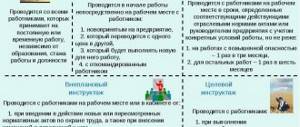Occupational safety training is required for all company employees without exception and is carried out once every 3 years. Timely testing of knowledge will allow you to protect yourself from administrative penalties and protect your subordinates from work-related injuries. The distance format of the courses will allow an individual approach to the aspirations, based on the convenience and wishes of the Customer. Training should be carried out once every 3 years at an average cost of 3,500 rubles.
Who is required to have a labor protection certificate?
Article 225 of the Labor Code of the Russian Federation states that all employed persons (heads of organizations and individual entrepreneurs, including) must confirm their knowledge. But naturally, all employers are interested in the question: how to organize this procedure correctly, and most importantly, economically?
Naturally, not every employer can afford to send the entire team to undergo occupational safety training at a licensed training center. In addition, in principle, it is not necessary to train all employees in an educational institution. However, there are those categories of workers who cannot do without it.
Let us turn to the legislative act, which for almost 15 years has been regulating the process of training and instructing workers on labor protection. This is Resolution of the Ministry of Labor of the Russian Federation and the Ministry of Education of the Russian Federation dated January 13, 2003 No. 1/29 “On approval of the Procedure...”. In accordance with this regulatory document, the following categories of students are required to complete the 40-hour training course “Occupational Safety and Health for Managers and Specialists” directly at the training center:
- Management of organizations and their deputies.
- Individual entrepreneurs.
- Key specialists and engineers of enterprises (chief engineers, chief technologists, etc.).
- Heads of structural units (heads of shifts, workshops, sections).
- Specialists by specialty.
- Specialists who are members of the certification commissions of enterprises on labor protection.
- Officials who are entrusted with labor protection responsibilities.
- Workers authorized for labor protection by labor collectives.
The procedure for training on labor protection for workers at the enterprise
I would like to immediately emphasize that occupational safety training takes place at the enterprise, and is followed by a knowledge test. The last point is the responsibility of members of a commission created at the enterprise from among responsible specialists who have undergone special training in the relevant profile at the training center.
Without undergoing occupational safety and health training and subsequent testing, no employee of the organization can be allowed to work independently - these are the rules that you can see in Resolution No. 1/29 and the Labor Code.
Why do you need to study occupational safety?
Paragraph 2, Part 7, Article 212 of the Labor Code of the Russian Federation states that one of the employer’s responsibilities is to teach safe methods and techniques for performing work.
Why is he charged with this? The fact is that if you do not study the labor protection requirements, any incorrect action by an employee can affect the quality of his work, and most importantly, affect safety during its performance, which helps preserve human health and life.
Of course, training is paid for by the employer. And the employee not only must, but is obliged to undergo this training (Article 214 of the Labor Code of the Russian Federation). You can feel the difference, right? Naturally, the legislation gives time for training and passing the exam - from the moment of hiring - this is one month, and this interval must be strictly observed.
Who is required to undergo occupational safety training and knowledge testing of occupational safety requirements?
Questions about who is required to undergo occupational safety training and testing of knowledge of occupational safety requirements and how long the certificate is valid are always relevant and cannot be ignored, especially if you are just mastering all the intricacies and nuances of occupational safety at the enterprise.
So, the following categories of workers must undergo training and knowledge testing:
- Employees of blue-collar professions. The frequency of occupational safety training for this category is determined by the employer (clause 2.2.3 of Resolution 1/29). Typically this is one year.
- Engineers, specialists and management staff. The frequency of training is no longer so frequent, once every three years (clause 2.3.1 Resolution 1/29).
- Employees hired under fixed-term employment contracts. They are subject to the same requirements as permanent employees. Even if they work for this employer for two months.
- Part-time workers - with frequency depending on the position (engineering technicians or working specialty).
- Transferred to another position.
Employers often think that if an hired employee gets a job with a “fresh” occupational safety certificate, then he does not need to teach and test his knowledge. But this is an erroneous judgment!
All hired employees must undergo new labor safety training (clause 2.2.1 Resolution 1/29). Even if this training was carried out in a training center according to a 40-hour program, the law is the law, “gnawing the granite of science” from scratch. The knowledge is still fresh in your memory and it will be easier in the exam.
There are also exceptions to the rules. Within a year from the date of employment, the following employees can be trained:
- occupational safety specialists, if the work experience has not been interrupted for five years;
- specialists or engineers in the safety of technological processes and production;
- teaching staff teaching labor protection;
- inspectors of State Supervision and Control in the field of labor protection.
Is it possible to conclude a student agreement for occupational safety training?
I once encountered a very controversial situation in terms of occupational safety training and compensation of money spent by the employee to the employer.
I changed the head of the department where I was his deputy, and he ordered an apprenticeship agreement to be drawn up with employees who had undergone occupational safety training.
They argued for a long time on this issue, only the banality of the norm helped.
- The employer is obliged to provide training on labor protection and not allow employees to work if there is no such training (Article 212 of the Labor Code of the Russian Federation). According to the Labor Code of the Russian Federation, all expenses are borne by the employer. That is, it is not legal to demand compensation for occupational safety training if an employee quits. After all, at another enterprise this certificate will no longer be valid; training must be completed from scratch!
- An apprenticeship agreement is concluded in the case of vocational training, for example, in a specific profession, specialty or qualification (Articles 198, 199 of the Labor Code of the Russian Federation).
The employer is obliged to create safe working conditions and labor protection, and, accordingly, pay for it, no matter how sad it may sound.
Normative base
The main document in matters of labor protection is, of course, the Labor Code. It directly outlines the responsibilities of both the employer “to ensure safety and working conditions that comply with state regulatory requirements for labor protection” (Article 22 of the Labor Code of the Russian Federation), and the employee to “comply with all requirements for labor protection” (Article 21 of the Labor Code of the Russian Federation). The principles of labor protection and the procedure for organizing the necessary activities, including training, are set out in detail in a separate section X (Articles 209–231).
In addition to the Labor Code of the Russian Federation, federal laws, orders and regulations, and by-laws have been developed. They establish specific requirements and standards that should be used when organizing specialized events and developing local documentation. Pay special attention to the following documents:
- The procedure for training and testing the knowledge of employees in terms of professional safety and labor protection ( Resolution of the Ministry of Education and the Ministry of Labor of the Russian Federation No. 1/29 of January 13, 2003 );
- Recommendations for organizing the work of the labor protection service in an organization (Resolution of the Ministry of Labor of the Russian Federation No. 14 of 02/08/2000);
- Model regulations on the committee (commission) for labor protection (Order of the Ministry of Labor of the Russian Federation No. 412n dated June 24, 2014).
In-house training on occupational safety and health
In order to really create safe working conditions for workers, you should know that occupational safety training in the organization plays a key role in this; now we will analyze everything step by step.
If you initially focus on the importance of labor protection during working hours, then employees will respect the safety of themselves and their colleagues.
By actually teaching employees to work safely, you will reduce injuries, the number of fines, the amount of work, and also preserve the health and, possibly, lives of people. ☺
To make the work of an occupational safety specialist a joy, work with the staff, teach and tell them. And so that they don’t make boring faces and sigh, organize the process in an interesting way by including video lectures, examples, and real-life cases in the training program.
But remember that well-prepared documents are no less important, because the employer whose interests you represent during working hours is responsible for their absence. So, let's start looking at it step by step.
I suggest watching a video in which I briefly talk about the main mistakes when preparing occupational safety training, and I will also leave a link to my YouTube channel, where you can learn a lot of useful information about occupational safety.
Regulations on training at the enterprise
The organization must develop a basic document - this is the Regulation on the procedure for training at the enterprise. It must describe in detail the procedure for conducting briefings, internships, training and knowledge testing.
And not just “pour water”, as is usually the case in Regulations downloaded from the Internet, but specify who is responsible for what, what documents are being prepared. Provide samples.
You should definitely follow this document as you work, and not put it on a shelf to gather dust. And in order for you to have a really working Regulation on occupational safety training (I share my best practices), which were thought out and felt at the time by the entire enterprise ☺, you can download it by following the link.
Sample training program on labor protection for employees of organizations
In order to properly build the learning process, a curriculum and training program on labor protection must still be developed for each of the working specialties, and a separate one for managers and specialists.
This is the responsibility of the heads of structural divisions; the labor protection specialist must only provide methodological assistance.
True, in practice you rarely see this. I have been convinced more than once that production workers have a lot of work to do, they need to earn money, and not deal with incomprehensible pieces of paper.
Therefore, it was necessary to ensure that the inspector did not have any complaints, and, accordingly, no fines. It’s good if everything happens as expected for you! So, let's continue, the training program should contain the following points:
- Explanatory note.
- Characteristics of the work of the working specialty.
- Syllabus with duration of each topic.
- Below is more detail about each topic.
- Recommended literature for self-study.
- Tickets with questions.
The Russian Ministry of Labor has developed an approximate training program on labor protection for employees of organizations (approved by the Ministry of Labor of the Russian Federation on May 17, 2004), into which you can add the missing points for each of the working professions and adjust them taking into account the characteristics of your enterprise.
The duration of training is regulated by Order of the Ministry of Labor No. 153, which states that the duration of occupational safety training cannot be less than 40 hours. The minimum number of hours of training under 273-FZ “On Education” is 16 hours. Therefore, as a rule, the number of hours of training on labor protection for workers is 20 hours, and for managers and specialists - 40.
As a sample of the design of a training program for blue-collar occupations, I leave you my training program, you can download it by clicking on the link.
You may have a question: “Who in the organization approves occupational safety training programs?” It is approved by the head of the organization, and if you have a trade union, then it is necessary to take into account his opinion (Article 372 of the Labor Code of the Russian Federation) and formalize the approval in accordance with the procedure. Once the occupational safety training programs are ready, they must be put into effect by order.
Training should be organized in the form of lectures, video tutorials, seminars, and so on. The duration of the training program is not regulated, but if local acts are changed or new ones are introduced, it must be revised.
For the convenience of working with a bunch of training programs, it is logical to make a list; you can always open and check the availability for the required position, whether the validity period expires; the inspector will definitely ask for the program.
And if your organization is a contractor for any large holding company, then the employee checking you will 100% check their availability.
Employer's liability
In my practice, there have been no cases where people are fined for the lack of a training program, but there are more than enough examples of such. If a GIT inspector comes to visit you, he will check thoroughly.
And even if you provide him with a protocol and a certificate of testing knowledge on labor protection by your commission, but there is no program for this position, administrative liability cannot be avoided.
Because it is immediately clear that the training is fictitious. Consequently, the fine will not be small (Part 3 of Article 5.27.1 of the Code of Administrative Offenses of the Russian Federation):
- the head of the organization in the amount of 15,000 to 25,000 rubles;
- entrepreneur - from 15,000 to 25,000 rubles;
- organization – from 110,000 to 130,000 rubles.
Therefore, it is better to get a staffing table from the HR department and prepare training programs for positions based on it, not forgetting that some specialties also need to be taught by type of work.
What are the consequences for an employer for not having trained employees?
Penalties against employers who allow untrained personnel to work are regulated by the Code of Administrative Offences. In particular, Article 5.27.1. The Code of Administrative Offenses of the Russian Federation provides for the following monetary equivalents of administrative penalties:
- For individual entrepreneurs and responsible officials - from 15,000 to 25,000 rubles.
- For legal entities - from 110,000 to 130,000 rubles.
If failure to fulfill the employer’s obligations to train his subordinates causes serious injury to the health or death of employees, then Article 143 of the Criminal Code of the Russian Federation may be applicable to it.
Commission for testing knowledge of labor protection requirements
In order to comply with the requirement of the Labor Code regarding occupational safety training, it is not necessary to send all employees to a training center and spend a lot of the employer’s money. The law does not prohibit saving.
For this purpose, a commission is created to test knowledge of labor protection requirements. The chairman must be the head of the organization or his deputy. You have every right to include a labor protection specialist, engineering specialists, for example, a chief engineer, a technologist, a mechanic, a power engineer, and so on, as members of the commission.
And also if there is a trade union at the enterprise, then a representative of the trade union or a representative of the interests of workers from your organization can take part in the work of the commission.
All members of the commission must be trained at a training center on labor protection. Otherwise, the protocol will be considered invalid.
An important point when preparing an order is the number of members. Three employees is the minimum number. You can read about this in paragraph. 1 clause 3.4 of the Training Procedure 1/29.
But I want to draw your attention to an important discrepancy. In para. 1 clause 10.7 GOST 12.0.004-2015 the commission must consist of at least five people, three of whom must be present at the knowledge test. So what is it really like?
The main document regulating the issues of occupational safety training is the Training Procedure. It is registered with the Ministry of Justice and is mandatory, but GOST 12.0.004-2015 is advisory. Of course, you can use it in your work, relying on the Procedure (Letter of the Ministry of Labor of Russia dated November 9, 2018 N 15-2/OOG-2749).
But in my practice, I always include at least five people in the commission, because there may be sick leave, business trips and other reasons why members may be absent, but a knowledge test must be carried out. Three out of five will probably be and that's enough.
At first, by the way, I doubted whether to count the chairman or only the members of the commission? A mistake is often made in the minutes - they include, in addition to the chairman, three members of the commission. This is a violation, because the chairman also makes the “Pass/Fail” decision and the number of votes and opinions must be odd.
The legal requirement to create a labor safety commission also applies to individual entrepreneurs - they must also conduct knowledge tests of their employees.
And if SOT is not provided due to the small number of personnel, then the commission can consist of only three employees. And they will be the chairman, his deputy and the secretary.
How to submit knowledge test results
Knowledge testing can take place either orally in the form of a question and answer, or in a test form. Based on the results, a protocol must be prepared, which must be drawn up in accordance with the form (clause 3.6 of Procedure No. 1/29).
Does it seem difficult to fill out the form? But very often mistakes are made, and if the inspector is principled, he may consider the protocol invalid and, moreover, issue a fine for violating the Training Procedure. Therefore, we prepare everything correctly and do not make mistakes. I will list the typical ones and those that I have encountered in practice:
- You cannot omit or omit the name of the occupational safety training program. Workers of several professions can take a knowledge test at once, and each of them must have its own protocol. It is also not allowed to list programs in one protocol separated by commas.
- The training hours are not indicated in the protocol, or they do not correspond to the number specified in the program.
- Protocols do not have serial numbers.
- It is necessary to fill in all lines and columns in the protocol; omissions are not allowed. In addition, it is also not allowed to edit the form at your own discretion, because it is mandatory.
- The protocol does not allow the use of abbreviations in recording positions, structural units, personal data of employees or members of the commission.
- The positions in the protocol must clearly correspond to the staffing table.
- Check the presence of all signatures in the protocol of both those being audited and members of the commission. Even if an employee “failed” the exam, he is required to sign an autograph.
Certificate of testing knowledge of labor protection requirements
In addition to the protocol, members of the commission prepare a certificate of successful inspection - a document confirming occupational safety training. It is considered valid if it contains the signature of the chairman of the commission and the seal.
When filling out, it is not allowed to shorten the name of the person being inspected and the position, or to make corrections with a pen; similar errors mentioned above are not made.
Employees of any enterprise who have successfully passed the knowledge test are required to have their ID with them at all times during working hours. In the event of an inspection, inspectors often ask employees of the organization to show their occupational safety certificate. And if he has nothing to show, then the government representative has every right to remove him from work without further thought. You will also face administrative liability.
It seems like a small thing, but it’s very unpleasant, considering the size of the fines. From my own experience, I found that it is difficult to convince employees to always carry their ID with them; they always left it in the locker. But several times they wrote explanatory notes due to absence and the situation changed. It is clear that these notes would not have been put into practice, but it was quickly possible to discipline employees without shouting and swearing.
The certificate form is mandatory and cannot be edited.
Who has the right to conduct training?
Educational organizations that meet a number of requirements have the right to occupational safety training:
- have a license to conduct educational activities;
- composition of teachers who specialize in the field of labor protection;
- material and technical base, which ensures the conduct of full-fledged classes.
Approximate plans and training programs are drawn up by the Ministry of Labor and Social Development; on their basis, training organizations develop and approve their own programs, which include lectures and seminars, business games, computer programs, etc. Distance learning is possible.
If the training is carried out by a commission that is created within the organization itself, it must have at least 3 people who have already been trained and tested for knowledge of labor protection requirements. Representatives of trade unions may be included in the commission.
What to do if an employee fails the knowledge test
I have come across situations where an employee is “careless” in studying and preparing for an exam and, naturally, does not pass it. In this case, the unsatisfactory result is recorded in the protocol and the employee who did not pass the test signs it. Members of the commission are preparing an order for suspension from work until the exam is passed successfully, but for a period of no more than one month (clause 3.8 of the Training Procedure and Article 76 of the Labor Code of the Russian Federation).
More details about the removal of an employee in the following articles.
How is knowledge tested?
After on-the-job training, the work manager takes an oral exam from the workers. Knowledge of instructions, local regulations, as well as additional instructions related to production features is tested.
Managers and specialists are required to undergo testing at a training organization (or pass a commission exam) once every 3 years. This applies to scheduled inspections.
Extraordinary inspections are associated with the same reasons as extraordinary briefings (see above). The initiator of the inspection regulates its procedure and the scope of the knowledge being tested.
Based on the results of testing knowledge of labor protection requirements, a protocol is drawn up, which reflects its results.
Since occupational safety training and knowledge testing are directly related to the safety of people, they are strictly controlled.
Control functions are assigned to the federal labor inspectorate. The employer is responsible for the timeliness of training, and the employer and the training organization are responsible for the quality. Return to list
Legal documents
According to the law, Art. 225 of the Labor Code of Russia, clause 2.1.2 of the Resolution, for all subjects starting a new position, training instructions regarding labor protection issues are conducted. The director is obliged to provide training in how to perform work, internships, and assistance in production.
Curriculum, subject, and discipline programs are developed by authorized persons of the executive branch. They are approved in the manner established by Russian law by the Federal Service Rostrud. In accordance with Art. 31 of Federal Law No. 323-FZ, by order No. 477n of the Ministry of Health and Social Development of the Russian Federation, a list of actions was approved when assistance should be provided.
Clause 2.2.4 of the law states that training courses for employees should be held at least once a year. Persons hired undergo training within 1 month after admission. For enterprise workers, training is carried out once a year, for managers and supervisors - once every three years.
Educational institutions themselves develop and approve programs, in accordance with Art. 12 of Federal Law No. 273-FZ, part 5. Rostrud and the authorized government body approves the list of activities in accordance with Art. 31 Fed. Law No. 323-FZ on occupational safety training.









